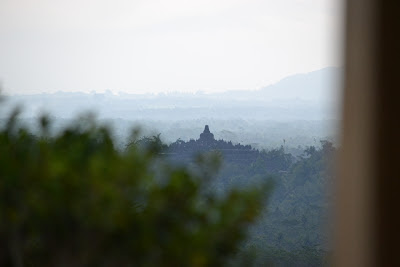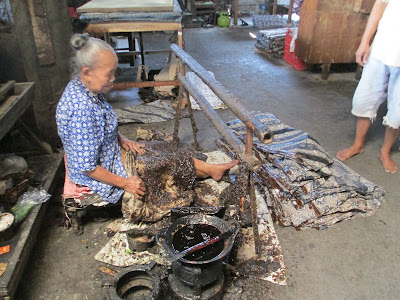Mt Merapi, Central Java (photo LP)
Considered the most important island in the vast archipelago of Indonesia, Java is at the centre of Indonesian culture and industry. Stretching for more than 1,000 km, Java is framed by the Indian Ocean to its south and the Java Sea in the north with Sumatra bordering its west coast and Bali immediately to the east. The volcanic, tropically green and ruggedly beautiful island of Java is about the size of England. It's population is about 105 million - nearly half of Indonesia's entire population.
We started touring around the vicinity of Yogyakarta and after visiting the Buddhist Temple ofrBorobudur we had lunch at the stunning Amanjiwo (peaceful soul) hotel, which overlooks the Temple; it was a superb lunch in a truly spiritual location.
 |
| Borobudur fromo the Amanjiwo hotel restaurant (photo Christine Simmonds) |
Of the four days I spent with friends in Central Java, there was one that was absolutely amazing. My friend, Christine, who had visited the area previously had chosen to take us to the Sultan's Palace in Yogyakarta and then to some small villages, known to her driver, which included artisan artists...in batik, soy products and masks. And what a day of contrasts we encountered.
 |
| The view to the private residence of the Sultan and his family (photo LP) |
Keraton Kasultanan Ngayogyakarta Hadiningrat or now better known by the name of Yogyakarta Palace is the center of Javanese culture living museum that is in the Special Region Yogykarta (Daerah Istimewa Yogyakarta). Not just becomes the place to live for the king and his family, the palace is also a main direction of cultural development of Java, as well as the flame guard of the culture. At this place tourists can learn and see directly on how the Javanese culture continues to live and be preserved. Yogyakarta Palace was built by Pangeran Mangkubumi (Prince Mangkubumi )in 1755, several months after the signing of the Perjanjian Giyanti (the Agreement Giyanti). Banyan forest (Hutan Beringin) was chosen as the place for building the palace because the land was between two rivers that were considered good and protected from possible flooding. Although already hundreds of years old and were damaged by the massive earthquake in 1867, Yogyakarta Palace buildings still stand firmly and well maintained. (www.YogYes.com)
The Palace "retainers" (photo LP)
After leaving the opulence of the Palace we ventured into the hinterland to visit a batik making family business...the batik is hand printed and waxed over many processes before it is put in the sun to dry...the conditions appeared primitive to us, but the cloth is prepared with care, precision and expertise in such a simple environment.
 |
| An old lady works with molten wax, sealing the edges of the fabric (photo LP) |
 |
| The wax is painted onto the fabric (photo LP) |
 |
| The fabric is then boiled to remove the wax and rinsed before the net pattern and more wax is added (photo LP |
 |
| The final product is dried in the sun (photo LP) |
After leaving the batik artisan's village we went to another village which "specialised" in the making of tofu and other soy products. The skills are passed down through the generations and the current owner of the family tradition has had the small business since 1972. His family sells the products through the local markets.
The tofu boiling on the stove having being strained in the vat below (photo LP)
...and then the final stop of the day before another lovely lunch was to the home, in another village of a mask maker. He doesn't own a telephone and doesn't have a bank account, but supplies masks to the theatres and opera companies of Europe, having been marketed through his Art School.
 |
| Topeng ( mask) by Mas Jamhari, Bantul Provence, (photo LP) |
The topeng (mask) which I bought (photo Christine Simmonds)
And so to a restaurant, opposite a rice paddy to relax and enjoy the locals going about their business in another small village...
The day was one of contrasts...and extremely humbling. The people I encountered were not "poor" although their circumstances are very different to those in the cities. They are people who request little of life...and those I met maintained a sunny and friendly disposition, even when probed for information, and photographed by interested westerners...and we shared laughs over the photos as I always do...
Preparing the vegetables for the market (photo LP)







Comments
Post a Comment